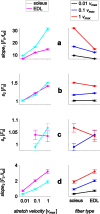Impact of lengthening velocity on the generation of eccentric force by slow-twitch muscle fibers in long stretches
- PMID: 39043889
- PMCID: PMC11381483
- DOI: 10.1007/s00424-024-02991-4
Impact of lengthening velocity on the generation of eccentric force by slow-twitch muscle fibers in long stretches
Abstract
After an initial increase, isovelocity elongation of a muscle fiber can lead to diminishing (referred to as Give in the literature) and subsequently increasing force. How the stretch velocity affects this behavior in slow-twitch fibers remains largely unexplored. Here, we stretched fully activated individual rat soleus muscle fibers from 0.85 to 1.3 optimal fiber length at stretch velocities of 0.01, 0.1, and 1 maximum shortening velocity, vmax, and compared the results with those of rat EDL fast-twitch fibers obtained in similar experimental conditions. In soleus muscle fibers, Give was 7%, 18%, and 44% of maximum isometric force for 0.01, 0.1, and 1 vmax, respectively. As in EDL fibers, the force increased nearly linearly in the second half of the stretch, although the number of crossbridges decreased, and its slope increased with stretch velocity. Our findings are consistent with the concept of a forceful detachment and subsequent crossbridge reattachment in the stretch's first phase and a strong viscoelastic titin contribution to fiber force in the second phase of the stretch. Interestingly, we found interaction effects of stretch velocity and fiber type on force parameters in both stretch phases, hinting at fiber type-specific differences in crossbridge and titin contributions to eccentric force. Whether fiber type-specific combined XB and non-XB models can explain these effects or if they hint at some not fully understood properties of muscle contraction remains to be shown. These results may stimulate new optimization perspectives in sports training and provide a better understanding of structure-function relations of muscle proteins.
Keywords: Contractile behavior; Give; Skeletal muscle; Soleus; Stretch.
© 2024. The Author(s).
Conflict of interest statement
The authors declare no competing interests.
Figures



Similar articles
-
Fiber-type dependence of stretch-induced force enhancement in rat skeletal muscle.Muscle Nerve. 2010 Nov;42(5):769-77. doi: 10.1002/mus.21744. Muscle Nerve. 2010. PMID: 20976780
-
How velocity impacts eccentric force generation of fully activated skinned skeletal muscle fibers in long stretches.J Appl Physiol (1985). 2022 Jul 1;133(1):223-233. doi: 10.1152/japplphysiol.00735.2021. Epub 2022 Jun 2. J Appl Physiol (1985). 2022. PMID: 35652830
-
Fatiguing stimulation increases curvature of the force-velocity relationship in isolated fast-twitch and slow-twitch rat muscles.J Exp Biol. 2019 Aug 9;222(Pt 15):jeb204545. doi: 10.1242/jeb.204545. J Exp Biol. 2019. PMID: 31292165
-
Muscle mechanics: adaptations with exercise-training.Exerc Sport Sci Rev. 1996;24:427-73. Exerc Sport Sci Rev. 1996. PMID: 8744258 Review.
-
Functional and structural adaptations of skeletal muscle to microgravity.J Exp Biol. 2001 Sep;204(Pt 18):3201-8. doi: 10.1242/jeb.204.18.3201. J Exp Biol. 2001. PMID: 11581335 Review.
Cited by
-
Consecutive SSCs increase the SSC effect in skinned rat muscle fibres.Pflugers Arch. 2025 Jun;477(6):873-888. doi: 10.1007/s00424-025-03088-2. Epub 2025 May 8. Pflugers Arch. 2025. PMID: 40338284 Free PMC article.
References
MeSH terms
Substances
Grants and funding
LinkOut - more resources
Full Text Sources
Research Materials
Miscellaneous

